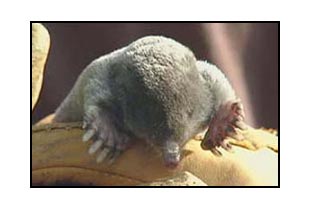THE SEVEN DWARVES
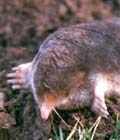 |
Eastern Mole
(Scalopus aquaticus)
Total Length - 3 1/4 - 8 3/4 inches
Tail Length - 3/4 - 1 1/4 inches
Weight - 3 - 5 ounces
|
|
CLASSIFICATION
Kingdom: Animalia
Phylum: Chordata
Class: Mammalia
Order: Insectivora
Family: Talpidae
Subfamily: Talpinae
Genus: Parascalops
Species: Parascalops brewerii |
|
Of the seven North American mole species, the Eastern Mole has the greatest distribution in the United States. Also known as the Common or Grey Mole, it is the subject of most homeowner complaints in this country. Regarded as the most capable excavator of all moles, an Eastern Mole can exert a lateral digging force equivalent to nearly 32 times its own body weight and can construct 150 feet of new tunnels in a single day.
The species was given the Latin name "aquaticus" by the great taxonomist Linnaeus who discovered a specimen dead in a well and presumed this mole to be adept in water. This was an unfortunate misnomer as Easterns are the least capable swimmers of all the New World moles. There are at least seven commonly recognized subspecies of Eastern Moles in North America. |
|
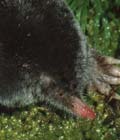 |
Hairy-tailed Mole
(Parascalops breweri)
Total Length - 5 1/2 - 6 3/4 inches
Tail Length - 7/8 - 1 3/8 inches
Weight - 1 3/8 - 2 1/4 ounces
|
|
CLASSIFICATION
Kingdom: Animalia
Phylum: Chordata
Class: Mammalia
Order: Insectivora
Family: Talpidae
Subfamily: Talpinae
Genus: Parascalops
Species: Parascalops brewerii |
|
The Hairy-tailed Mole is the smallest of the eastern species. As its name implies, its tail is covered entirely by black fur and is sometimes tipped in white. This mole boasts 44 teeth, and with the Star-nosed Mole, has a greater number than any other North American mammal except the opossum (50). It is reported that Hairy-tailed Moles will live in shared tunnel systems after the breeding season and therefore might be the most social of the New World mole species. Although it is typically not as destructive as the Eastern Mole which shares much of its range, Hairy-tailed Moles can be a significant pest species in much of the eastern United States.
The Hairy-tailed Mole's scientific name (Parascalops breweri) was given in honor of Thomas M. Brewer, a naturalist who had gathered a collection of small mammals from New England. |
|
 |
Star-nosed Mole
(Condylura cristata)
Total Length - 6 - 8 1/4 inches
Tail Length - 2 1/3 - 3 1/4 inches
Weight - 1 - 2 5/8 ounces
|
|
CLASSIFICATION
Kingdom: Animalia
Phylum: Chordata
Class: Mammalia
Order: Insectivora
Family: Talpidae
Subfamily: Talpinae
Genus: Scapanus
Species: Scapanus townsendi |
|
The Star-nosed Mole is noted most for the striking 22 pink tentacles which sprout radially from its nose. It was once believed that this mole used its unique nose to detect subtle electric fields generated by its prey in water. However, neuroscientist Dr. Ken Catania of Vanderbilt University has discovered that the star is instead an incredibly sensitive tactile appendage, and may in fact provide this mole with the keenest sense of touch of any living mammal.
Unlike its North American counterparts, Star-nosed Moles are semi-aquatic and are excellent swimmers. This mole can hold its breath for up to three minutes and frequently prowls streams, creeks, ponds, and lakes in search of its food. Prey species include small minnows and crayfish in addition to the standard mole diet of soil invertebrates. Although it does construct underground burrow systems, the Star-nosed Mole's preference for swampy areas most often helps it to avoid conflict with human interests. |
|
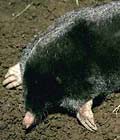 |
Townsend’s Mole
(Scapanus townsendii)
Total Length - 7 3/4 - 9 1/4inches
Tail Length - 1 1/4 - 2 inches
Weight - 4 3/8 - 7 3/8 ounces
|
|
CLASSIFICATION
Kingdom: Animalia
Phylum: Chordata
Class: Mammalia
Order: Insectivora
Family: Talpidae
Subfamily: Talpinae
Genus: Parascalops
Species: Parascalops brewerii |
|
The Townsend's Mole is the largest of the seven North American species. It uses its considerable bulk to great advantage when tunneling, and is regarded as the most damaging of the western mole species. Interestingly, some researchers have speculated that it might be the most omnivorous of the New World moles, and is believed to consume roots, bulbs, and tubers in addition to the traditional mole diet of soil invertebrates. Although its activity patterns are not well understood, the Townsend's Mole appears to be primarily nocturnal.
This mole is one of eight North American mammal species named for John Townsend, a notable 19th century naturalist. |
|
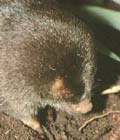 |
Coast Mole
(Scapanus orarius)
Total Length - 5 3/4 - 6 7/8 inches
Tail Length - 1 - 1 5/8 inches
Weight - 2 1/4 - 3 5/8 ounces
|
|
CLASSIFICATION
Kingdom: Animalia
Phylum: Chordata
Class: Mammalia
Order: Insectivora
Family: Talpidae
Subfamily: Talpinae
Genus: Scapanus
Species: Scapanus orarius |
|
The Coast Mole (also known as the Pacific Mole) is outwardly quite similar in appearance to the Townsend's Mole which shares much of its range, except that it is somewhat smaller in size. On close examination, the two species can also be differentiated by the evenly spaced unicuspids of the Coast Mole and the corresponding crowding evident in the Townsend's.
Like its larger counterpart, the Coast Mole is quite destructive to lawns and gardens where its range overlaps residential areas. This species seems to favor better-drained soils and trends toward deeper tunneling. Individual Coast Moles have been known to construct several hundred mounds during the course of a single winter. |
|
 |
Broad-footed Mole
(Scapanus latimanus)
Total Length - 5 1/4 - 7 1/2 inches
Tail Length - 7/8 - 1 3/4 inches
Weight - 2 7/8 - 4 ounces
|
|
CLASSIFICATION
Kingdom: Animalia
Phylum: Chordata
Class: Mammalia
Order: Insectivora
Family: Talpidae
Subfamily: Talpinae
Genus: Scapanus
Species: Scapanus latimanus |
|
While its range slightly overlaps some areas occupied by both Coast and Townsend's Moles, the Broad-footed (or Broad-handed) Mole is easily distinguished from the two by its hairy tail. Not surprisingly, this mole does have broad palms. However, they are no more remarkable than those gracing the forefeet of most other North American mole species. Broad-footed Moles prefer moist soils which facilitate tunneling.
Although its burrowing can be unsightly, this mole is generally not as destructive as its two more maligned counterparts of the Pacific Northwest. |
|
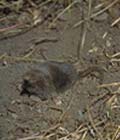 |
Shrew-Mole
(Neurotrichus gibbsii)
Total Length - 4 - 5 1/8 inches
Tail Length - 1 1/4 - 1 5/8 inches
Weight - 1/4 - 1/2 ounces
|
|
CLASSIFICATION
Kingdom: Animalia
Phylum: Chordata
Class: Mammalia
Order: Insectivora
Family: Talpidae
Subfamily: Talpinae
Genus: Neurotrichus
Species: Neurotrichus gibbsii |
|
The Shrew-Mole (also known as Gibbs' Mole) is an interesting study. As its name implies, it represents a combination of shrew and mole traits, both physical and behavioral. As one might expect, it is the smallest of the New World moles. It also lacks the overly developed front paws of its North American cousins, and consequently is the least adept digger. However, the positioning of the front paws is similar to that of most quadrupeds, and the Shrew-Mole enjoys an agility superior to the "true moles."
Shrew-Moles are capable of tunneling, but a large percentage of their burrowing is confined to the shallow litter layer of the soil and appears as troughs rather than true tunnels. Unlike other moles, it often climbs into low bushes to feed. However, its diet is similar to those of its more fossorial relatives, and its chief prey is the earthworm.
Due to its unique habits and preference for wilder environs, this mole rarely attains pest status. |
|
|
|

